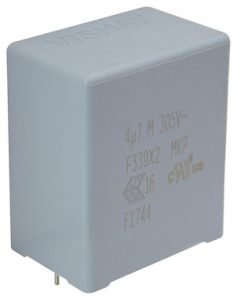EMI suppression film capacitors to AEC-Q 200:
Vishay has introduced automotive grade X2 EMI suppression film capacitors for 50 and 60Hz.

Called F339X2 305VAC, the series is qualified to both AEC-Q200 (rev D) and IEC 60384-14: 2013 / AMD1: 2016 grade IIB.
To comply with the new humidity grading in IEC 60384-14: 2013 / AMD1: 2016 grade IIB, the series withstands a temperature humidity bias (THB) testing of 85°C, 85% RH for 500 hours at rated voltage “with high stability on capacitance and dissipation factors”, which translates into greater robustness and longer service life in harsh application conditions, claims the firm. Intended applications are in EMC filters for automotive and industrial power inverters. Capacitors lead pitches choice is 15, 22.5 or 27.5mm and capacitors span 0.1μF to 4.7μF – with tolerances down to ±10% and a permissible dc voltage of 630V. Encapsulation is a flame-retardant UL-class 94 V-0 plastic case with an epoxy resin seal. Pb-free devices are RoHS-compliant. Samples and production quantities of the new X2 capacitors are available now.
Comments
Post a Comment